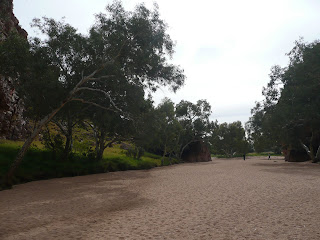
Trekking west again. White flowering gums, craggy red rock formations and hilly country on the way out of Cloncurry on the Barkly Highway. The Burke & Wills memorial commemorating where the explorers camped by the Corella River was worth a stop and then further down the road we checked out the turn off to Fountain Springs, which are permanently filled springs filtered through layers of quartz according to the sign. 24 klms of rough dirt road - maybe next time.
Mt Isa on the horizon is quite spectacular with the three smelter stacks smoking away, and the town set amongst the ore rich Selwyn Ranges on the banks of the Leichhardt River. It borders the Savannah country to the north, rich cattle country to the south, Simpson desert to the west, and pastoral counry to the east. The Isa is home to one of the worlds biggest underground copper, silver, lead and zinc mines. Also the biggest and richest rodeo in Australia which features a packed programme of events for a week every August. 
Mt Isa Smelter Stacks
Our first night in the Caravan Park we were entertained by a very loud concert close by and as you can imagine our thoughts were if this is a Thursday night, what will Friday and Saturday nights be like in this town. It was none other than Jimmy Barnes belting out his numbers at decibel overload! Fortunately for us and the rest of the guests at this camp site, it was a one night stand.
Ade hasn't been here for 42 years when he worked underground, so it was his turn to play tour guide. Lake Moondarra about 15 minutes drive, supplies water for the town and for the production of ores from the mine. Also a haven for the locals being the closest large body of water and we noted canoe races underway, fishing and boating activities, and barbeques around the shore line.
The lookout gives a great 360 degree view of the countryside. We spent a few days checking out the town and tourist areas and then it was time to keep heading west.
Camooweal was the next town on the stopover, 13 kilometres before the border. Beautiful countryside through red rock mountain ranges supported by thick grasses and low growing trees at the foothills. No doubt there has been plenty of moisture across the west this year as Ade doesn't remember it being anything but dry and dusty when he was here last. We saw more copper mines and also a phosphate project as well. This is the best highway surface so far and no road trains. They road trains are enormous with up to four wagons attached and over 50 metres long! Lunch at Camooweal and a fuel stop. Not many fuel stops in this outback land of ours.
Must be time to post another food note and this is a beauty! Do not eat meat pie in car park at Camooweal. Starving hawk swooped and knocked meat pie out of Ade's hand. Ade very pissed off. Shouted and waved at hawk and said a few rude words! 
Obviously, this town is not a destination so we pushed on to the "Border" and a further 260 kilometres to Barkley Homestead and the first fuel stop. Goodbye Queensland, see you next year some time!
We were expecting these amazing roads when we reached the Northern Territory as we had been told by numerous travellers. Speed limit went from 110klm per hour to 130. Not with the van in tow, mate. Let me tell you, it was bouncy, bouncy to Avon Downs about 80 k's away which has nothing but a police station. Then the roads improved but we saw no sign of habitable existence until we reached "The Barkly Homestead'. It is an oasis in the outback with lovely shady trees and red, red dirt. We didn't unhitch the van for the one night stop before heading for Tennant Creek.
















































